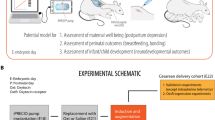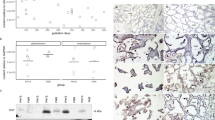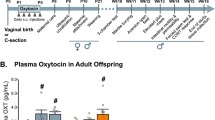Abstract
To use sheep and rat models and demonstrate that stressors activate fetal glucocorticoid (GC) system, corticotrophin-releasing factor (CRF) system and cholinergic neurotransmitter system (ChNS) leading to propulsive colonic motility and in utero meconium passage. Immunohistochemical studies (IHS) were performed to localize GC-Receptors, CRF-receptors and key molecules of ChNS in sheep fetal distal colon. CRF expression in placenta and enteric endocrine cells in fetal rat system were examined and the effects of acute hypoxia on in utero meconium passage was tested. IHS confirmed localization and gestation dependent changes in GC-Rs, CRF-Rs and cholinergic markers in sheep fetal colon. Rat placenta and enteric endocrine cells express CRF and gastrointestinal tract express CRF-Rs. Hypoxia is a potent inducer of meconium passage in term fetal rats. Stress is a risk factor for in utero meconium passage and laboratory animal models can be used to develop pharmacotherapy to prevent stress-induced in utero meconium passage.
This is a preview of subscription content, access via your institution
Access options
Subscribe to this journal
Receive 12 print issues and online access
$259.00 per year
only $21.58 per issue
Buy this article
- Purchase on Springer Link
- Instant access to full article PDF
Prices may be subject to local taxes which are calculated during checkout



Similar content being viewed by others
References
Momoh JT . Hirschsprung's disease: problems of diagnosis and treatment. Ann Trop Paediatr 1982; 2: 31–35.
Wiswell TE, Tuggle JM, Turner BS . Meconium aspiration syndrome: have we made a difference? [see comments]. Pediatrics 1990; 85: 715–721.
Ahanya SN, Lakshmanan J, Morgan BL, Ross MG . Meconium passage in utero: mechanisms, consequences, and management. Obstet Gynecol Surv 2005; 60: 45–56.
Usher RH, Boyd ME, McLean FH, Kramer MS . Assessment of fetal risk in postdate pregnancies. Am J Obstet Gynecol 1988; 158: 259–264.
Miller FC, Read JA . Intrapartum assessment of the postdate fetus. Am J Obstet Gynecol 1981; 141: 516–520.
Richey SD, Ramin SM, Bawdon RE, Roberts SW, Dax J, Roberts J et al. Markers of acute and chronic asphyxia in infants with meconium-stained amniotic fluid. Am J Obstet Gynecol 1995; 172: 1212–1215.
Tache Y, Bonaz B . Corticotropin-releasing factor receptors and stress-related alterations of gut motor function. J Clin Invest 2007; 117: 33–40.
Tache Y, Martinez V, Million M, Rivier J . Corticotropin-releasing factor and the brain-gut motor response to stress. Can J Gastroenterol 1999; 13 (Suppl A): 18A–25A.
Martinez V, Wang L, Rivier J, Grigoriadis D, Tache Y . Central CRF, urocortins and stress increase colonic transit via CRF1 receptors while activation of CRF2 receptors delays gastric transit in mice. J Physiol 2004; 556: 221–234.
Million M, Wang L, Martinez V, Tache Y . Differential Fos expression in the paraventricular nucleus of the hypothalamus, sacral parasympathetic nucleus and colonic motor response to water avoidance stress in Fischer and Lewis rats. Brain Res 2000; 877: 345–353.
Williams CL, Villar RG, Peterson JM, Burks TF . Stress-induced changes in intestinal transit in the rat: a model for irritable bowel syndrome. Gastroenterology 1988; 94: 611–621.
Miampamba M, Sharkey KA . c-Fos expression in the myenteric plexus, spinal cord and brainstem following injection of formalin in the rat colonic wall. J Auton Nerv Syst 1999; 77: 140–151.
la Fleur SE, Wick EC, Idumalla PS, Grady EF, Bhargava A . Role of peripheral corticotropin-releasing factor and urocortin II in intestinal inflammation and motility in terminal ileum. Proc Natl Acad Sci USA 2005; 102: 7647–7652.
Hillhouse EW, Grammatopoulos DK . The molecular mechanisms underlying the regulation of the biological activity of corticotropin-releasing hormone receptors: implications for physiology and pathophysiology. Endocr Rev 2006; 27: 260–286.
Maillot C, Million M, Wei JY, Gauthier A, Tache Y . Peripheral corticotropin-releasing factor and stress-stimulated colonic motor activity involve type 1 receptor in rats. Gastroenterology 2000; 119: 1569–1579.
Grundy D, Al-Chaer ED, Aziz Q, Collins SM, Ke M, Tache Y et al. Fundamentals of neurogastroenterology: basic science. Gastroenterology 2006; 130: 1391–1411.
Jones SA, Brooks AN, Challis JR . Steroids modulate corticotropin-releasing hormone production in human fetal membranes and placenta. J Clin Endocrinol Metab 1989; 68: 825–830.
Bruder ED, Jacobson L, Raff H . Plasma leptin and ghrelin in the neonatal rat: interaction of dexamethasone and hypoxia. J Endocrinol 2005; 185: 477–484.
Takahashi LK, Goh CS . Glucocorticoid facilitation of cholinergic development in the rat hippocampus. Neurosci 1998; 83: 1145–1153.
Coukos G, Monzani A, Saletti C, Petraglia F . [Noradrenaline and interleukin-1 stimulate CRF secretion from human placental cells in culture]. Medicina (Firenze) 1988; 8: 441–442.
Lakshmanan J, Ahanya SN, Rehan V, Oyachi N, Ross MG . Elevated plasma corticotrophin release factor levels and in utero meconium passage. Pediatr Res 2007; 61: 176–179.
Lakshmanan J, Salido E, Amidi F, Amidi E, Raj R, Ross MG . Rat placenta expresses corticotrophin releasing factor protein and mRNA. Reproductive Sciences 2007; 14 (1 Suppl): 175A.
Frim DM, Emanuel RL, Robinson BG, Smas CM, Adler GK, Majzoub JA . Characterization and gestational regulation of corticotropin-releasing hormone messenger RNA in human placenta. J Clin Invest 1988; 82: 287–292.
Lakshmanan J, Richard JD, Liu GL, Ross MG . Corticotrophin releasing factor is a fetal gut hormone. Reprod Sci 2007; 14 (1 Suppl): 251A.
Kawahito Y, Sano H, Kawata M, Yuri K, Mukai S, Yamamura Y et al. Local secretion of corticotropin-releasing hormone by enterochromaffin cells in human colon. Gastroenterology 1994; 106: 859–865.
Richard JD, Lakshmanan J, John TA, Ross MG . Rat fetal gastrointestinal tract is a target organ for corticotrophin-releasing factor family neuropeptides. Am J Obstet Gyn 2006; 195 (6 Suppl): S214.
Ross B, Bradley K, Nijland MJ, Polk DH, Ross MG . Increased fetal colonic muscle contractility following glucocorticoid and thyroxine therapy: implications for meconium passage. J Matern Fetal Med 1997; 6: 129–133.
Acosta R, Oyachi N, Lee JJ, Lakshmanan J, Atkinson JB, Ross MG . Mechanisms of meconium passage: cholinergic stimulation of electromechanical coordination in the fetal colon. J Soc Gynecol Investig 2005; 12: 169–173.
Lakshmanan J, Oyachi N, Ahanya SA, Liu G, Mazdak M, Ross MG . Corticotropin-releasing factor inhibition of sheep fetal colonic contractility: mechanisms to prevent meconium passage in utero. Am J Obstet Gynecol 2007; 196: 357.
Lakshmanan J, Oyachi N, Liu GL, Choi GY, Ross MG . Fetal colonic enteric nervous system is a site of glucocorticoid-induced gastrointestinal maturation. Reprod Sci 2007; 14 (1 Suppl): 287A.
Lakshmanan J, Liu GL, Oyachi N, Ross MG . Evidence for pre-receptor metabolism of glucocorticoids in ovinee fetal distal colonic enteric nervous system. Reprod Sci 2007; 14 (1 Suppl): 288A.
Lakshmanan J, Liu GL, Oyachi N, Ross MG . Localization and gestation-dependent pattern of CRF-receptos (R1, R2) expression in ovine fetal distal colon. Reprod Sci 2007; 14 (1 Suppl): 258A.
Seasholtz AF, Valverde RA, Denver RJ . Corticotropin-releasing hormone-binding protein: biochemistry and function from fishes to mammals. J Endocrinol 2002; 175: 89–97.
Lakshmanan J, Liu GL, Oyachi N, Ross MG . Cellular localization of corticotrophin releasing factor binding protein (CRF-BP) in fetal ovine distal colon: a possible local inhibitor of stress-induced colonic motility. Reprod Sci 2007; 14 (1 Suppl): 288A.
Lakshmanan J, Lips KS, Liu GL, Ross MG . Maturational changes in ovine fetal colonic cholinergic circuitry parallels plasma glucocorticoid surge. Reprod Sci 2007; 14 (1 Suppl): 249A.
Lakshmanan J, Liu GL, Ross MG . Localization of inhibitory and stimulatory muscarinic receptor subtypes in ovine fetal distal colon: implications for meconium passage. Reprod Sci 2007; 14 (1 Suppl): 168A.
Acknowledgements
This research was supported by grants from the March of Dimes Foundation (MGR) and the National Institutes of Health (JL).
Author information
Authors and Affiliations
Corresponding author
Additional information
Disclosure
Jayaraman Lakshmanan has received grant funding from NIH R03. Michael Ross has received grant funding from the March of Dimes.
Rights and permissions
About this article
Cite this article
Lakshmanan, J., Ross, M. Mechanism(s) of in utero meconium passage. J Perinatol 28 (Suppl 3), S8–S13 (2008). https://doi.org/10.1038/jp.2008.144
Published:
Issue Date:
DOI: https://doi.org/10.1038/jp.2008.144



